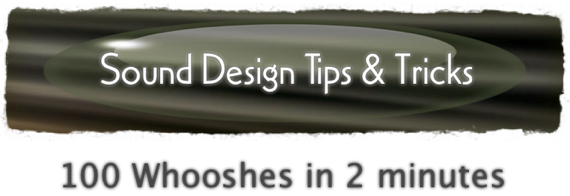Every sound designer has to make new whooshes in record time. Whenever I’m stuck in that position I’ve always tried to come up with some quick automated ways. A long time ago I made a template that allows me to quickly make new whooshes, and on top of it it’s incredibly fun to “operate” since you get to actually orchestra the whooshes in realtime. I’m still using this template on some material in these days. On top of it, throw virtually any sound at it, bit of protools knowledge, and you’re set. It works best if you have a control surface (C24, Procontrol, D-command, Control 8 etc.) so you can throw the faders.
disclaimer: The first time you set this up, it’ll take you approx 45-60 minutes. Every consecutive use will only take you a few minutes.
- Create 10-20 tracks with continuously edited sounds for about 4-5 minutes. Place a sound, and use the “duplicate” command plenty of times :)
- Include sounds with specific characters you want (i.e Growls, distortion, tones etc.)
- Include single-shot sounds like hits, explosions etc. as well as tonal sounds. These will create the peak-points.
The following video-clip will solo each track to show what types of sounds I’ve picked. Notice there are several types of tonal ranges, flanged sounds etc. Track “Hit1” and “Hit2” are typical “punch” hits.
Variation of Lib sounds put on several tracks. “Bara” track contains sounds by maestro Dave Farmer.
- -Create 2-3 submix busses, and route similar sounds to each bus
- Apply realtime processing on each submix bus using a plethora of movement creators like:
— Dopplers (GRM, Waves)
— Low-end enhancers like Rbass, Recti-fi or Lo-air (Waves)
— Flangers/Phasers (Soundtoys, Waves)
— Envelope filters (Soundtoys) etc….
— Anything else that creates movement or distorts the way in fun new ways
- Setup busses with side-chain ducking. i.e. if Submix 1 has the more “agressive” sounds, then Submix 1 should duck down submix 2 etc.
- Other fun ways are to use envelope filters and create side-chaining on these to low-pass filter a submix bus by another
- If a sound is not “steady” enough, add a few long delays (2000ms etc.) on that track to fill in the gaps etc.
- If you need to beef up the mid-points, use something like waves C4 and/or McDSP ML4000 to expand the low-end at the loudest point of the submix.
- Setup the “hit” sounds as you peak point on the whoosh. This is a bit tricky, but you’ll get the hang of it;
— Send the main submix signal to a aux gate, so it only opens up at the loudest point. This will act as the trigger for the hits.
— Gate the “hits”, and open up the gate using the signal from the above aux-gate. The signal output will become the trigger for the peak points on the submix busses
— Now, duck down the submix busses, using the output of this chain.
- Be careful not to setup a feedback ducking chain, otherwise it’ll end up “mute”
The following video shows one track solo’d, with the processing on it, which is only Waves Doppler and Digidesign’s Recti-fi (for low-end enhancement)
So you got that far, that’s cool ! Now the fun really begins.
- While you’re playing the protools session, start interactively move the faders, controlling what each in and out of the whoosh will sound like.
- Make lots of mistakes, and simply go nuts at times. Don’t try to over-control it.
- Keep recording. In every take you’ll end up with probably 2-5 new whooshes that are usable.
- Random automate other stuff (doppler speed etc.)
- Once you get sick of the sounds you’re currently using, delete some of the sounds, and put new ones on the tracks.
- Turn some plugs on/off, anything goes. Mondo-mod is awesome to automate tracks by itself by simply LFO’ing the volume. make sure to offset the speed for each track. Sit back and enjoy your protools session auto-creating whooshes.
The following video shows all the tracks being used, and me moving the faders in random a bit to make the sounds in realtime.
…. enjoy…..
Written by Charles Deenen for Designing Sound



Great idea. I’ve been doing a wayyyy scaled-back version of this. Today I go nuts! Always great contributions from Charles Deneen. Thanks for sharing.
j
jrrome, I’m glad you like it !
Hi Charles. Thank you so much for this! I’ve always wondered how these type of aggressive whoosh designs were made. Could you elaborate a bit more on the routing of your tracks and busses? Would you mind speaking a bit more on side-chain ducking, and gates and exactly where in the chain you use these and how specifically it is set up? I noticed, also, that you doubled the output of Bus 2. Where else are you routing the bus 2 tracks? What are you using Bus 1 for?
Your routing seems like the crucial factor in understanding how these designs are created. Any elaboration would be greatly appreciated. Thank you in advance!
Cool stuff Charles, thanks.
Unfortunately, I didn’t understand much of this process, please make a step by step video if you can showing how this is set up.
Thanks
Gavin
Hello, does anyone have a PT session for this? I’d love to have a crack at it, but wasn’t too sure how to set up the routing correctly.
Regards,
Jacob
Awesome tutorial! Certainly has me thinking of other creative usages for sub mixes and ducking.
gavin, jordan, shoot me an email at [email protected], and I’ll send you the template
Hey there,
I was wondering if anyone would mind sending me a copy of the template for the whoosh session? I would greatly appreciate it and thank you again Charles for a great video.
[email protected]
hi Angelo.
you get Charles Whoosh session, can you share it with me. coz Charles not get it anymore.
/ lars
Wow! I love it when I read articles like this. A creative eye opener!
Great tutorial.
Very Cool…thanks Charles!
Kyma users: you can now download the version of ‘100 whooshes in 2 minutes’ here: http://jedsound.com/blog/?page_id=1020
Feel free to go nuts with it, expand its features and share your tips with us ;-) J-E
anyone got a rough pt template for this?
Hi anybody in here, still have Charles Deenen template session for Protools ?
i hope.
best regards
Lars
This is really great – making wooshes for dance music often turns into drab whitenoise builds, which is pretty boring. However, it took me a while to really figure out the details of this tutorial. One thing that needed to click for me was this: most gates I set up are all-or-nothing gates that provide a sort of staccato effect. That’s NOT how the gate is used here: the gate simply provides for a sudden boost in level once you hit a certain threshold (maybe… 12-18dB?), and with good hold/release settings on the gate you can also tail it out neatly.
I suppose the sounds themselves need to convey a lot of movement/excitement to provide the needed interest (the FX can help with that).
I used to build wooshes by applying massive reverbs to audio hits, and reversing these for buildups. The method described here is way more fun/intuitive. Kudos.
Awesome to read this Khan! If you wouldn’t mind to share you template with me. A friend wants it in Logic or Reaper, I don’t have either. i don’t even have my own template in protools anymore.
[email protected]
cheers ! Charles Deenen
This process can now be highly simplified by a new software suite from the guys at sound morph. It’s called Wavewarper. Check it out!!!
Used it today for the first time and it blew my mind. Still a bit buggy with the preset functions so remember your settings by doing a screen capture just in case. Well worth the $99 for the bundle now. Two other amazing sound design tools are included as well.
Enjoy!
Thank you for a great article! I tried to recreate everything in Cubase, didn’t truly succeed with the last part of the tutorial, but I managed to generate a lot of nice whooshes and impacts which I can use as a construction kit. :)
Great stuff! I just finished adding this functionality to my Nuendo 7 template. The routing had to be worked out due to the limitations of the Group and FX tracks, but it functions the same way.